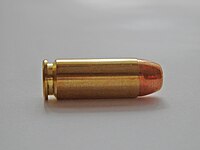
Photo from wikipedia
Special Operations Forces (SOF) Service members endure frequent exposures to blast and overpressure mechanisms given their high training tempo. The link between cumulative subconcussive blasts on short and long-term neurological… Click to show full abstract
Special Operations Forces (SOF) Service members endure frequent exposures to blast and overpressure mechanisms given their high training tempo. The link between cumulative subconcussive blasts on short and long-term neurological impairment is largely understudied. Chronic exposures may develop neurodegenerative diseases such as brain dysfunction, cognitive decline, mild cognitive impairment, and dementia. This hypothesis remains unproven due to lacking ecologically valid occupational blast exposure surveillance among SOF Service members. The study purpose was to measure occupational blast exposures in a close quarter battle (CQB) training environment and to use those outcomes to develop a pragmatic cumulative blast exposure (CBE) estimate model. Four blast mannequins equipped with a field-deployable wireless Blast Gauge System (Gen 7; BlackBox Biometrics, Inc., Rochester, NY) were positioned in breaching positions during CQB training scenarios. Mannequins were exposed to flashbangs and three interior breaching charges (single strand roll-up interior charge, 300 grain (gr) explosive cutting tape (ECT), and Jelly charge). Mean blast measures were calculated for each mannequin for flashbangs (n=93, single strand roll-up interior charge (n=80), 300 gr ECT (n=28), and Jelly charge (n=71). Mean peak blast pressures per detonation are reported as follows: 1) flashbangs (1.97 psi); 2) single strand roll-up interior charge (3.88 psi); 3) 300 gr ECT (2.78 psi); and Jelly charge (1.89 psi). Pragmatic CBE estimates for SOF Service members suggest 36.8 psi, 184 psi, and 2,760 psi may represent daily, weekly, and training cycle cumulative pressure exposures. Estimating blast exposures during routine CQB training can be determined from empirical measures taken in CQB environments. Factoring in daily, weekly, training cycle, or even career length may reasonably estimate cumulative occupational training blast exposures for SOF Service members. Future work may permit for more granular exposure estimates based on operational blast exposures and those experienced by other military occupational specialties. Keywords: Dosimetry, overpressure, traumatic brain injury, concussion, subconcussive.
Journal Title: Journal of neurotrauma
Year Published: 2022
Link to full text (if available)
Share on Social Media: Sign Up to like & get
recommendations!